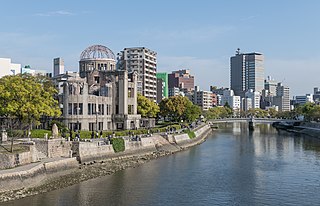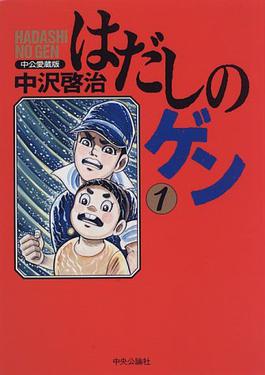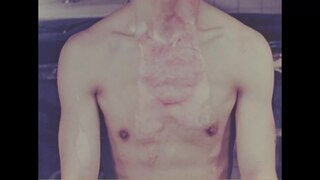This article needs additional citations for verification .(September 2015) |
This is a list of cultural products made about the atomic bombings of Hiroshima and Nagasaki. It includes literature, film, music and other art forms.
This article needs additional citations for verification .(September 2015) |
This is a list of cultural products made about the atomic bombings of Hiroshima and Nagasaki. It includes literature, film, music and other art forms.
In The Photobook: A History, Vol. 1, Martin Parr and Gerry Badger wrote "These three books, along with Kikuji Kawada's 'symbolic reportage' in Chizu (The Map, 1965), constitute photography's most significant memorials to the defining event in twentieth-century Japanese history." [5]

Hiroshima is the capital of Hiroshima Prefecture in Japan. As of June 1, 2019, the city had an estimated population of 1,199,391. The gross domestic product (GDP) in Greater Hiroshima, Hiroshima Urban Employment Area, was US$61.3 billion as of 2010. Kazumi Matsui has been the city's mayor since April 2011. The Hiroshima metropolitan area is the second largest urban area in the Chugoku Region of Japan, following the Okayama metropolitan area.

The Hiroshima Peace Memorial, originally the Hiroshima Prefectural Industrial Promotion Hall, and now commonly called the Genbaku Dome, Atomic Bomb Dome or A-Bomb Dome, is part of the Hiroshima Peace Memorial Park in Hiroshima, Japan and was designated a UNESCO World Heritage Site in 1996.

Barefoot Gen is a Japanese historical manga series by Keiji Nakazawa, loosely based on Nakazawa's experiences as a survivor of the Hiroshima atomic bombing. The series begins in 1945 in and around Hiroshima, Japan, where six-year-old Gen Nakaoka lives with his family. After Hiroshima is destroyed by the bombing, Gen and other survivors deal with the aftermath. The series was published in several magazines, including Weekly Shōnen Jump, from 1973 to 1987. It was adapted into three live-action film versions directed by Tengo Yamada, which were released between 1976 and 1980. Madhouse released two anime films, one in 1983 and the other in 1986. In August 2007, a two-night live-action television drama series aired in Japan on Fuji TV.

Hibakusha is a word of Japanese origin generally designating the people affected by the atomic bombings of Hiroshima and Nagasaki at the end of World War II.

Yoshito Matsushige was a Japanese photojournalist who survived the dropping of the atomic bomb on the city of Hiroshima on 6 August 1945 and took five photographs on the day of the bombing in Hiroshima, the only photographs taken that day within Hiroshima that are known.

The Hiroshima Panels are a series of fifteen painted folding panels by the collaborative husband and wife artists Toshi Maruki and Iri Maruki completed over a span of thirty-two years (1950–1982). The Panels depict the consequences of the atomic bombings of Hiroshima and Nagasaki, as well as other nuclear disasters of the 20th century. Each panel stands 1.8 metres x 7.2 metres.

The Hiroshima Maidens are a group of 25 Japanese women who were school age girls when they were seriously disfigured as a result of the thermal flash of the fission bomb dropped on Hiroshima on the morning of August 6, 1945. They subsequently went on a highly publicized journey to get reconstructive surgery in the US in 1955.

Hiroshima Peace Memorial Park is a memorial park in the center of Hiroshima, Japan. It is dedicated to the legacy of Hiroshima as the first city in the world to suffer a nuclear attack at the end of World War II, and to the memories of the bomb's direct and indirect victims. The Hiroshima Peace Memorial Park is visited by more than one million people each year. The park is there in memory of the victims of the nuclear attack on August 6, 1945, in which the United States dropped an atomic bomb on the Japanese city of Hiroshima. The Hiroshima Peace Memorial Park was planned and designed by the Japanese Architect Kenzō Tange at Tange Lab.

Atomic tourism or nuclear tourism is a form of tourism in which visitors witness nuclear tests or learn about the Atomic Age by traveling to significant sites in atomic history such as nuclear test reactors, museums with nuclear weapon artifacts, delivery vehicles, sites where atomic weapons were detonated, and nuclear power plants.
Toshi Maruki was a Japanese painter. Maruki is best known for the Hiroshima Panels series that she and her husband Iri Maruki produced collaboratively from around 1950. The Marukis took on heavy themes such as the atomic bomb, genocide, and environmental pollution, and constantly voiced their anti-war and peace message through their art. Toshi Maruki is also known as an accomplished picture book author.

The Nagasaki Atomic Bomb Museum is in the city of Nagasaki, Japan. The museum is a remembrance to the atomic bombing of Nagasaki by the United States on 9 August 1945 at 11:02:35 am. Next to the museum is the Nagasaki National Peace Memorial Hall for the Atomic Bomb Victims, built in 2003. The bombing marked a new era in war, making Nagasaki a symbolic location for a memorial. The counterpart in Hiroshima is the Hiroshima Peace Memorial Museum. These locations symbolize the nuclear age, remind visitors of the vast destruction and indiscriminate death caused by nuclear weapons, and signify a commitment to peace.
Yōsuke Yamahata was a Japanese photographer best known for extensively photographing Nagasaki the day after it was bombed.
Shōmei Tōmatsu was a Japanese photographer. He is known primarily for his images that depict the impact of World War II on Japan and the subsequent occupation of U.S. forces. As one of the leading postwar photographers, Tōmatsu is attributed with influencing the younger generations of photographers including those associated with the magazine Provoke.

On 6 and 9 August 1945, the United States detonated two atomic bombs over the Japanese cities of Hiroshima and Nagasaki. The bombings killed between 129,000 and 226,000 people, most of whom were civilians, and remain the only use of nuclear weapons in an armed conflict. Japan surrendered to the Allies on 15 August, six days after the bombing of Nagasaki and the Soviet Union's declaration of war against Japan and invasion of Japanese-occupied Manchuria. The Japanese government signed the instrument of surrender on 2 September, effectively ending the war.

White Light/Black Rain: The Destruction of Hiroshima and Nagasaki is an HBO documentary film directed and produced by Steven Okazaki. It was released on August 6, 2007, on HBO, marking the 62nd anniversary of the first atomic bombing. The film features interviews with fourteen Japanese survivors and four Americans involved in the 1945 atomic bombings of Hiroshima and Nagasaki.
Kikuji Kawada is a Japanese photographer. He co-founded the Vivo photographic collective in 1959. Kawada's books include Chizu and The Last Cosmology (1995). He was included in the New Japanese Photography exhibition at the Museum of Modern Art, New York in 1974 and was awarded the Lifetime Achievement Award from the Photographic Society of Japan in 2011.

Ken Domon was a celebrated Japanese photographer known for his work as a photojournalist and as a photographer of Buddhist temples and statuary.

The Nagasaki National Peace Memorial Hall for the Atomic Bomb Victims is a commemorative monument in Nagasaki, Japan, situated next to its Atomic Bomb Museum. The Peace Park is nearby.

Tsutomu Yamaguchi was a Japanese marine engineer who survived both the Hiroshima and Nagasaki atomic bombings during World War II. Although at least 160 people are known to have been affected by both bombings, he is the only person to have been officially recognized by the government of Japan as surviving both explosions.
Atomic bomb literature is a literary genre in Japanese literature which comprises writings about the atomic bombings of Hiroshima and Nagasaki.